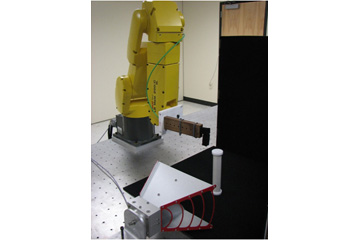Invisibility Tube Conceals 3-D Objects

It may not be a cape of magical, silvery material, but it's still an invisibility cloak. A tube made of an insulating material striped with long, thin strips of copper makes objects within it invisible to microwaves. Researchers at the University of Texas at Austin reported their cloaking chamber Jan. 25 in the New Journal of Physics.
Different lab groups have been trying to cloak objects from light waves and microwaves for years. Previous efforts rendered objects invisible along a plane, in two dimensions, by bending microwaves around the objects. Last year researchers demonstrated an invisibility cloak that worked in three dimensions, concealing a bump on a reflective surface.
This newest cloak makes three-dimensional objects invisible without using reflective surfaces or specialized microwave chambers. "We don't need mirrors, we don't need waveguides, we just built a cloak with a cover around an object," said Andrea Alù, an engineer at Texas-Austin who led the research.
The cloak makes objects invisible to microwaves from all angles, Alù and his colleagues found. They aimed microwaves at an 18-centimeter-long cylinder, fitted inside the invisibility chamber, from different angles. They found reduced microwave reflection from the cylinder no matter where they observed it.
Objects reflect light and other electromagnetic waves when they're just sitting around. That's how your eyes can see them and how devices such as radar detectors can sense airplanes and ships. Alù's cloak works by reflecting electromagnetic waves in a way that cancels out the waves that the object reflects. "It's kind of an interference between the two," he told InnovationNewsDaily. "The combination of the two becomes invisible."
The secret to the cloak's exactly canceling waves is a "metamaterial," a man-made material that doesn't appear in nature and that has, as one paper put it, "exotic electromagnetic properties." Alù first published his ideas for how to make an invisibility cloak using this canceling metamaterial in 2005 and has been working on the idea ever since.
Of course, the cylinder he cloaked in this latest study is still visible to the naked eye, which detects light waves, not microwaves. He said his technique works best with objects of comparable size to the wavelengths they're trying to hide from. Thus cigar-size cylinders are well masked from microwaves, which can be several centimeters long, while microscopic objects are best masked from visible light waves. So Alù's metamaterials can't be used to cover certain boy wizards or anybody else, he said. "You can't use this to cloak a human body or a large object to visible light." He's working on creating a material that will cloak a microscopic object from visible light, which would be useful for machines that take microscopic photos.
Get the world’s most fascinating discoveries delivered straight to your inbox.
As for the cloak he's already made, Alù thinks it would work well for stealth operations. "But it's superior to stealth, because stealth cancels the reflection but not the shadow of an object," he said.
This story was provided by InnovationNewsDaily, a sister site to LiveScience. You can follow InnovationNewsDaily staff writer Francie Diep on Twitter @franciediep. Follow InnovationNewsDaily on Twitter @News_Innovation, or on Facebook.


